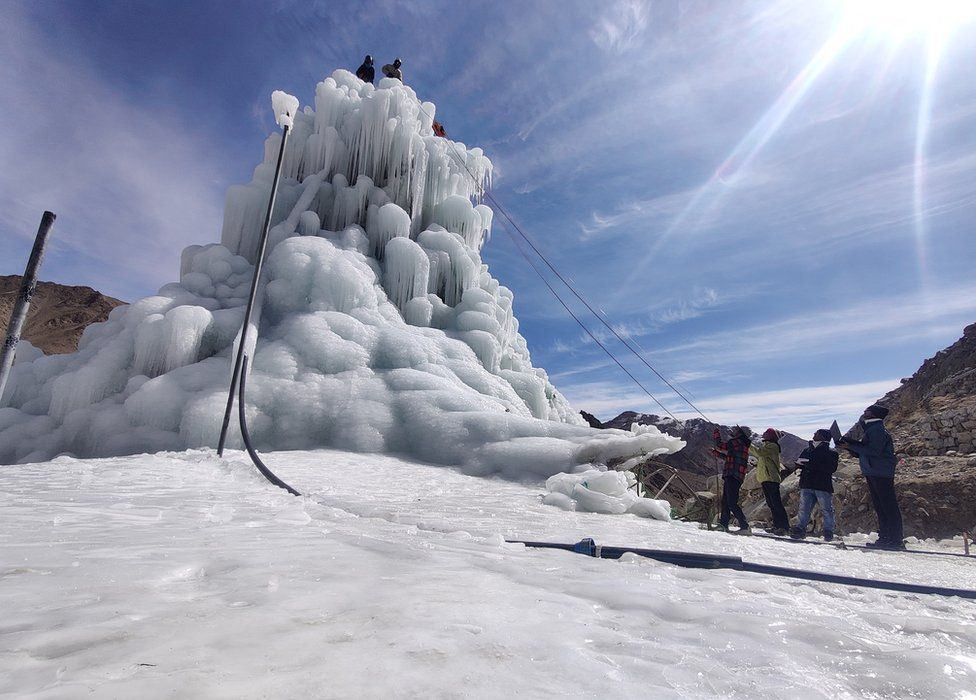
©University of Aberdeen via BBC
Vocabulary:
I will read the words, meanings, and sample sentences. Then, repeat after me.
- ice stupa /ahys STOO-puh/
- arid /AR-id/
- wastewater /WEYST-waw-ter/
- sub-zero /suhb-ZEER-oh/
- in its infancy /in its IN-fuhn-see/
[noun] – a form of glacier grafting technique that creates artificial glaciers used for storing winter water
Some towns are using ice stupas to increase their water supply.
[adjective] – very dry and without enough rain for plants
The Atacama Desert is the aridest place in the world.
[adjective] – water that is not clean because it has already been used in homes, businesses, factories, etc.
The golf course management uses wastewater to irrigate the grass.
[adjective] – temperatures below zero degrees
Sub-zero temperatures are expected in some regions of the country this February.
[phrase] – to be very new and still developing
The recruitment system is still in its infancy, so expect some changes.
Article reading:
Please read the whole article. Then, I will check your pronunciation and intonation.
Scientists from the University of Aberdeen are currently developing ice stupas to solve the water crisis in Ladakh, Northern India, situated in the Himalayas. The region is one of the aridest places worldwide, with most settlements experiencing acute water shortages to grow crops, especially in April and May. The problem has gotten worse due to climate change, resulting in natural glaciers melting. To solve this, the artificial glaciers are used to retain wastewater as ice in the winter and then release it as meltwater in the spring. Pipes are buried below the frost level before the final segment rises vertically. The stream water eventually rushes up and out of the tube’s raised tip like a fountain when pressure builds in the pipe. The sub-zero air then freezes the water into a pyramid-like shape.
The ice stupas were built by Engr. Sonam Wangchuk in 2013, but researchers say the glaciers are still “in their infancy.” However, Aberdeen’s Cryosphere and Climate Change research group is improving the technology to use it more widely. “Our research has shown that mountain glaciers in Ladakh are retreating at an increasing rate, so it is clear that interventions such as ice stupas are essential,” said Prof. Matteo Spagnolo from the university team. The artificial glaciers can release millions of liters of water each year, and researchers claim that the size and shape make them efficient, economical, and easy to manage.
The ice stupas were built by Engr. Sonam Wangchuk in 2013, but researchers say the glaciers are still “in their infancy.” However, Aberdeen’s Cryosphere and Climate Change research group is improving the technology to use it more widely. “Our research has shown that mountain glaciers in Ladakh are retreating at an increasing rate, so it is clear that interventions such as ice stupas are essential,” said Prof. Matteo Spagnolo from the university team. The artificial glaciers can release millions of liters of water each year, and researchers claim that the size and shape make them efficient, economical, and easy to manage.
Discussion Questions:
I will read each question. Then, please answer them.
- Has your country experienced a water shortage? Please tell me more about it.
- How do you conserve water?
- What would you do if your water supply got cut?
- In your opinion, will ice stupas be a permanent solution to the water crisis in Ladakh?
- Aside from global warming, what other factors do you think affect or cause a water shortage?
Summarization
Please summarize the whole article using your own words and expressions. You will have one minute to prepare before you answer.
Describe:
Please explain the definition of each word listed below based on your understanding. You can provide example sentences if needed.
- settlement
- acute
- retreat
- intervention
- economical